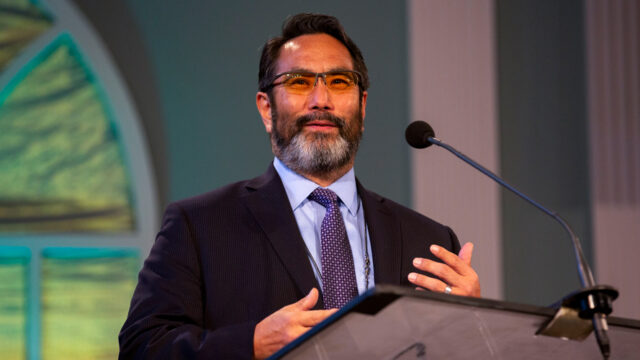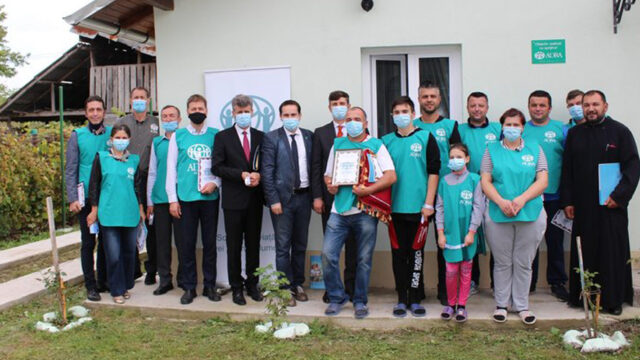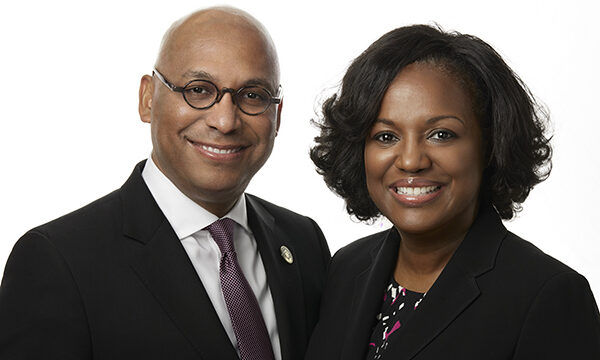How do we make peace among us?

I’ve been living with this story for 50 years now, ever since I first was caught by it on a gray January day in my fourth-grade classroom. Back then, and naturally enough, it was a story about the derring-do of a child only a bit older than me. That’s why I found it in a classroom stocked with child-friendly stories.
Later on it became a story about cool-headed, tactical planning, perhaps because that was the quality I needed most as a young and middle-aged adult when unbridgeable chasms yawned at every turn, and professional and personal disruptions filled my days.
More recently, the story—which occurred at just about the time this journal was being founded 170 years ago—has become for me a potent metaphor for how we bridge the great divides that naturally enough grow up between individuals, in groups, in congregations, and even between large Christian organizations.
I suspect that I’m not done with it yet, even in this telling. Like the poet Robert Frost, “I shall be telling this with a sigh somewhere ages and ages hence,”1 when another life moment shows me another facet I’ve been missing through the years. And that’s as it should be: good stories—great stories—are never fully understood.
• • •
By the fall of 1847, three decades of thawing relations between the United States and Canada had largely obliterated memories of the shooting war that had erupted over the boundary Niagara River during the War of 1812. A booming economy south of the river and great economic potential north of it had convinced government and business leaders on both sides. A bridge was needed to span the turbulent river that marked the border between the British Empire and the nation that had declared its independence from Great Britain just 70 years earlier.
An engineering firm was hired to design the first suspension bridge over what was deemed an unbridgeable and treacherous chasm—the Whirlpool Rapids, just above the famous Falls. At 800 feet across, and 225 feet above the water, it was the narrowest point between the two sides. Depending on which version of the story you prefer, supervisor of the building works Theodore Hulett either personally solved the architectural puzzle of how the bridge could be built, or else got his brainstorm from watching boys fly kites out over the Whirlpool Rapids.
Hulett organized a kite-flying contest for January, the coldest month of the winter, with the goal of landing a kite—and its string—on the other side of the chasm. Dozens of Canadian and American boys responded to the challenge, which included a prize of $5, worth more than $150 in both Canadian and U.S. currencies today. One talented kite-flyer, 16-year old Homan Walsh, crossed the river well above the rapids and successfully landed his kite on the American side early in the contest, only to have the string break. Marooned by bad weather on the Canadian side of the Niagara for more than a week, Walsh finally retrieved his kite and tried again two weeks later, letting out hundreds of feet of string as the prevailing westerly Canadian winds carried his kite—symbolically named “Union”—out over the swirling rapids. Toward nightfall, as the winds died down, “Union” settled in a tree on the U.S., and the string was secured by Hullet’s associates.
Now a single string—a kite string—united the two territories.
And over that string, Hulett’s engineers drew a slightly heavier string, riding on a silver ring. And over the slightly heavier string, an even heavier string. And over the heavier string, a rope. And over the rope, the first, thin metal wire—until strand by strand, one small step at a time, incrementally but irresistibly, the foundation for the first suspension bridge over the Niagara River was built.
And it all rested on a kite string.
• • •
This isn’t the usual plotline for a story about how big divides get crossed. As we typically tell such tales, a great, even heroic, gesture is required to bridge the unbridgeable. Richard Nixon must go to China. Anwar Sadat must go to Jerusalem. Presidents and prime ministers must stand before the cameras in some distant, neutral territory to grasp hands and symbolize the thawing of a Cold War. What can be accomplished by something as unsubstantial—and yes, fragile—as a single kite string?
But behind the grand heroic gestures that capture our imaginations and the headlines, there are a hundred smaller moments on which all reconciliations ultimately depend. Someone picks up the phone—even the Red Phone—and calls a person long deemed an “enemy.” Two diplomats from warring sides go for an unobserved walk in some snowy Swiss forest. A private note passed from hand to hand around a tense negotiating table signals a new solution to an old and intractable quarrel.
Yes, let it be said: there’s a string—a kite string—beneath all hopeful moments when our broken, proud humanity makes peace with other broken, proud human beings. Someone swallows hard, and deliberately puts aside the memory of the latest injury to send an olive branch—or just a twig—to an opponent on the other side of the board room or the church business meeting. Someone prays for weeks about the apostle Paul’s admonition—”Forgive each other; just as the Lord has forgiven you” (Col 3:13)—and hesitatingly picks up a basin and a towel. Leaders—yes, even church leaders—deliberately put aside the clamoring of partisans and the assertions of correctness, and send the text that simply, elegantly says: “Let’s talk.”
All reconciliations ultimately depend on things as fragile as kite strings.
• • •
Thirteen years and several “shooting wars” ago, I began an editorial in this journal with these lines: “If I had an extra million dollars and the inclination to give it away, I’d probably create the Homan Walsh Possibilities Award, and annually bestow a healthy chunk of that money on some Adventist who goes about the difficult business of bridging the divides among us.”2
It’s a sadness to tell you today that I have yet to give away the first Homan Walsh Possibilities Award—not sad because I still don’t have the extra million dollars, but sad because there seem to be so few candidates deserving of such a prize.
You don’t need me to tell you that we live in fractious times. The toxic, intensely partisan political culture in all nations of the world, but particularly in the United States just now, has seeped into the company of those who say they “keep the commandments of God, and have the testimony of Jesus Christ” (Rev 12:17, KJV). From behind the barricades of blogs and lava-infused newsletters, we launch fusillades against the decisions and integrity of those who disagree with us. They aren’t simply those who disagree: they are “wrong,” or rather “WRONG!” No one so foolish, spineless, careless, or thoughtless has ever previously walked on the earth than the ones we quickly demonize.
Hiding behind pseudonyms and website addresses that publicly position us as positive affirmers of “whatever is true, whatever is honorable, whatever is just, whatever is pure, whatever is pleasing, whatever is commendable” (Phil 4:8, NRSV3), we tear into each other with all the ferocity of carnivores—a special irony in a movement where the fiercest battles are frequently between vegetarians and vegans. “Red meat”—hot, reckless rhetoric designed to win us friends and negatively influence our enemies—is the special of the day.
Any conflict, from the classic congregational battles over the color of the sanctuary carpet to the intense and prolonged controversy about whether to ordain qualified women to the gospel ministry, has fuel enough these days to both warm its advocates and still scorch those deemed “enemies” on the other side.
In His prophecy of the turmoil that would precede His Second Coming, Jesus unflinchingly described the end-times as an era when “the love of many will grow cold” (Matt 24:12, NRSV). It follows just as logically that the hatred of many, even for other “believers,” will grow hot as well, for like the dragon who inspires such enmity, they sense that their time is short (Rev. 12:12).
Am I overdrawing the story, or do you also know this narrative as well?
Is there still a way to bridge what seems unbridgeable? Is there still a moment when we could imagine—even fleetingly—a kite string landing on the other side? Are there still thousands—no, millions—of honest-hearted Seventh-day Adventists who have heard and listened to the appeal of Paul?
“From now on, therefore, we regard no one from a human point of view; even though we once knew Christ from a human point of view, we know him no longer in that way. So if anyone is in Christ, there is a new creation: everything old has passed away; see, everything has become new! All this is from God, who reconciled us to himself through Christ, and has given us the ministry of reconciliation; that is, in Christ God was reconciling the world to himself, not counting their trespasses against them, and entrusting the message of reconciliation to us” (2 Cor 5:16-19, NRSV).
I believe that there are, in fact, a nearly uncountable number of faithful members of this pilgrim movement who still yearn for reconciliation, even with those who have injured them. Some of them remember a song that used to drift among the campfires of soldiers during the American Civil War, at just the time this denomination was organized in the 1860s:
“Many are the hearts that are weary tonight,
Wishing for the war to cease;
Many are the hearts looking for the right
To see the dawn of peace.
Tenting tonight, tenting tonight,
Tenting on the old camp ground.”
The future of this movement—“some say the world will end in fire, some say in ice”4—doesn’t, in fact depend preeminently on leaders in far-off conference or division offices who, we hope, will agree to talk, mend fences, and resume their trust in those with whom they disagree. Let it be clear: they have a helpful role to play, but they can only lead when others choose to follow. The decisive feature of the Adventist future won’t be determined chiefly at some future General Conference Session that finally decides on some elegant architecture to bridge our current unbridgeable chasms.
The future of this movement will be built on a hundred—no, a hundred thousand—small and fragile kite strings landed gracefully in places that haven’t seen enough of grace or kites in recent years. It will be built through reconciliations made across kitchen tables between spouses, and across board meeting tables among elders. It will occur when sharp-tongued Sabbath School combatants agree, at last, that “He is our peace; in his flesh he has made both groups into one and has broken down the dividing wall, that is, the hostility between us” (Eph 2:14, NRSV).
Here’s how it could happen.
1 Pray for a reconciling spirit. All great things begin with prayer, “and the greatest of these is love” (1 Cor 13:13). This means frequently praying “against the grain”—against the natural tendency of our hearts to assume our own correctness, especially in matters we deem “truth.” We all are cognizant that we at least occasionally get facts wrong: George H. W. Bush was the 41st, not 43rd president of the United States—a fact that copyeditors everywhere have been warned to check in recent weeks. We are much more reluctant to admit, however, that we could—even potentially—be in error on some long-held point of view like the perceived “imperative” of a plant-based diet, or the ultimate authority of the Holy Spirit in determining who receives which gifts to bless the church.
And we’ll never move an inch, never mind ascend the hill of the Lord, unless we begin praying with a sincerity heretofore unknown for an attitude of reconciliation with those whom we are sure are “wrong.” Such inner change doesn’t spontaneously appear in a moment when the church business meeting sings “Side by Side” or “Kum Bah Ya.” The emotions of any given moment will disappear just as quickly as they came unless there’s a consistent, persistent commitment to pray for reconciliation, first in our own hearts, and then in the hearts of those with whom we disagree. “Pray without ceasing”—and pray for reconciliation.
2 Be alert for olive branches—and kite strings. The smallest, slenderest of strands became the base of a bridge that ultimately carried locomotives. An olive branch may first appear as insubstantial as a twig—just another combustible to toss upon the flame of our deep anger. But those who have, through grace, acquired a reconciling spirit see signs of life where others just see fuel.
In the early years of our marriage, Debby and I soon enough developed a signal whenever we wanted to end an argument that had arisen over whether the toilet seat was returned to level, or the silverware returned to the drawer. One or the other of us would say with seeming gruffness, “I love you!”—to which the other would respond with equal seeming gruffness, “I love you, too!” We learned, as all long-married couples do, to see the small but hopeful signs that conflict needn’t last much longer—that we could soon enough again be laughing at the foolishness from which our quarrel sprang.
In board rooms this may be as momentary as a sigh, an opening of the chairman’s hands, a brief acknowledgement that there’s at least a little legitimacy in other ways of seeing. In executive committee sessions, this may mean congratulating a philosophical opponent on the clarity and thoughtfulness with which she has shared her perspective. Practice spotting—and offering—olive twigs, which may yet grow into branches.
3 Avoid the demagogues. These are the ones who insist that talking with “the other side” is “traitorous,” a sign of “creeping compromise,” a first step into error. Such misinformed and maladapted men and women haven’t been reading their Bibles much, for Scripture calls us repeatedly to demonstrate the same deep respect for those who oppose our ideas as we usually reserve for those who are our greatest cheerleaders.
Ellen White similarly reminds us of the unmatched example of Jesus: “Jesus did not suppress one word of truth, but He uttered it always in love. He exercised the greatest tact and thoughtful, kind attention in His relationships with the people. He was never rude, never needlessly spoke a severe word, never gave needless pain to a sensitive soul. He did not censure human weakness. He spoke the truth, but always in love.”5
Those who can both imagine and help to build bridges should expect that their motives will frequently be misunderstood by the partisans on both sides. Their loyalties and their motives will be the source of endless gossip to those who refuse to hear the gospel’s clarion call to peace within the household of faith. “Talking with the enemy” is not, as some would claim, a sign of unfaith, but of faith. Only confident faith, which rests on the merits of Jesus and not on the cleverness of logic, is competent to negotiate with those of opposing views.
And negotiate we must, for it’s only in clearly hearing what the other is saying when they are no longer ducking from our rhetorical Molotov cocktails that can lay the basis for determining what is really at issue, and how it might be resolved. Those who build bridges from fragile kite strings should expect to get “walked upon,” for the test of a bridge is ultimately whether it can bear traffic and become the path of communication and connection.
4 Stay at the task of peace. We frequently remind each other that “Rome wasn’t built in a day.” But then again, neither was Jerusalem. And if Jesus has gone to prepare a place for us (John 14:2), He has chosen to make the new Jerusalem a hallmark of His craftsmanship, even as His Spirit shapes the men and women who will, by grace, inhabit it. The multiple references in the Book of Acts and in the epistles of Peter, John, and Paul to conflict in the church illustrate that the task of reconciliation is as essential to the church of Jesus Christ as are the tasks of proclamation, evangelism, pastoral care, and compassion.
As long as there are humans in God’s church, reconciliation will be necessary, for even the closest of friends will frequently have to choose to be reconciled to each other instead of letting a difference of opinion blossom into a new world war. This can’t be accomplished by occasionally mumbling the prayer attributed to Francis of Assisi (“Lord, make me an instrument of Thy peace”) or humming John Lennon’s “Give Peace a Chance.” There will be hours—days, weeks, and months—of hard and often thankless effort for those who understand that unity is forged in fire, not dropped from the sky. Like every welding job, the welding of believer’s lives together will show both some heat and some friction if the bond is going to last. We will prize our unity only when we have given—and given up—something to achieve it.
Lastly, I want to resurrect that proposal for a prize I floated 13 years ago—the Homan Walsh Possibilities Award.
No, I haven’t found a million dollars for the winner, but I can promise you that all the resources of this journal—which Ellen White first envisioned in the year Homan flew his kite—will be available to celebrate and call righteous attention to that man or woman, teenager or child, who best exemplifies the spirit of kite flying—and peace-making—each year among us.
Send your nominees from 2018 to:
Bill Knott
Editor and Lover of Kites
Adventist Review
12501 Old Columbia Pike
Silver Spring, MD 20904
1 Robert Frost, “The Road Not Taken,” The Poetry of Robert Frost (New York: Holt, Rinehart, and Winston, Inc; 1969), p. 105.
2 Bill Knott, “One Strand at a Time,” Adventist Review (Oct. 13, 2005).
3 Bible texts credited to NRSV are from the New Revised Standard Version of the Bible, copyright © 1989 by the Division of Christian Education of the National Council of the Churches of Christ in the U.S.A. Used by permission.
4 Robert Frost, “Fire and Ice,” The Poetry of Robert Frost (New York: Holt, Rinehart, and Winston, Inc; 1969), p. 220.
5 Ellen G. White, Steps to Christ, (Mountain View, Calif.: Pacific Press Pub. Assn., 1892), p. 12.








